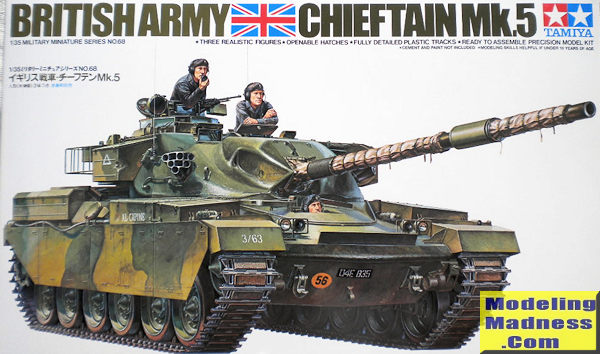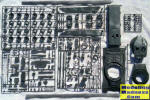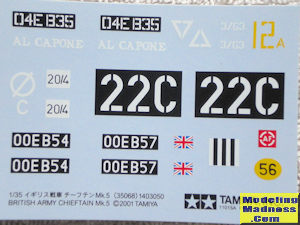
Tamiya 1/35 Chieftain Mk.5
| KIT #: | 68 |
| PRICE: | $22.00 when new |
| DECALS: | Three options |
| REVIEWER: | Rick Reinbott |
| NOTES: | 238 Parts |

| HISTORY |
Preliminary development of the Chieftain dates back to 1956 when British military authorities issued specification for the vehicle. Vickers Armstrong immediately began work on several prototypes, which were ready in 1960. A further seven experimental prototypes were delivered to the British Army in 1962 for use trials. In May 1963 the tank was officially adopted, and series production was begun; 40 examples of the Mk 1 were deilivered to British armor training centers for training purposes in 1964. In November 1966 the first Mk 2 models left the assembly line; the first Mk 3 models were ready in September 1969, followed by the Mk 3G, 3/2, 3/3, and 3/5, with the Mk 5 version being introduced in 1971.
When first introduced and for some time thereafter, the Chieftain was the heaviest main battle tank fielded by any Western nation. It was conventionally configured, with the driver in a forward compartment (in a reclining position, which aided in keeping overall vehicle silhouette low), the other three crew members in the turret, and the propulsion compartment at the rear. The hull was a cast and welded combination, and the turret was a casting. The Chieftain Mk. 5 had a 120mm L11A5 rifled gun fitted with a thermal shroud and a muzzle reference system (MRS) to enhance accuracy. The gun, which was fully stabilized and able to fire while on the move, had a range of 4,000 meters, which enabled the British to implement their philosophy of engaging targets at a maximum range for a high attrition rate. Secondary armament consisted of a 7.62mm coaxial machine gun, a 7.62mm machine gun on the commander’s cupola, and a .50-caliber-ranging machine gun mounted over the main gun, which was effective up to 2,500 meters. There were also 12 smoke dischargers, in groups of 6 on each side of the turret. Foreign users of the Chieftain included Iran and Kuwait. The Chieftain saw combat during the Iran-Iraq War of 1980-88 and during the 1990 Iraqi invasion of Kuwait.
| THE KIT |
 Upon
opening the box, you’re presented with three bags, with the top and bottom parts
for the turret and hull not being bagged. All parts are molded in dark green and
show nice detail. There is very little flash, although there are mold seams
around most parts, which will need to be scraped/ sanded for a smooth finish.
Ejector pin marks, other than those on the insides of the hatches, are kept to
the inside surfaces of parts, so they will be pretty much out of view after
assembly. The sprues indicate a copyright year of 1975.
Upon
opening the box, you’re presented with three bags, with the top and bottom parts
for the turret and hull not being bagged. All parts are molded in dark green and
show nice detail. There is very little flash, although there are mold seams
around most parts, which will need to be scraped/ sanded for a smooth finish.
Ejector pin marks, other than those on the insides of the hatches, are kept to
the inside surfaces of parts, so they will be pretty much out of view after
assembly. The sprues indicate a copyright year of 1975.
The slightly rough cast texture on the turret and hull is restrained and well represented. The .50-caliber cupola machine gun and both 7.62-mm machine guns are molded solid, so they’ll need to be hollowed out if you want to use the kit parts. The 120-mm main gun with the thermal sleeve is in two halves with the thermal sleeve fabric texture nicely done. Although the box art shows a dust cover on the gun manlet, there is no such part included in the kit, although it shouldn’t be difficult to scratch build one since the area is quite small. The lower hull part still has placement guides for batteries and holes from when the kit was motorized, so the holes should be filled in with a plastic card to keep light shining up into the empty interior. Plastic tow cables are included, although you may want to just use the cable ends and scratch build cables out of fine wire. The tracks are vinyl but nicely detailed and should look good on the finished model, especially since the top half will be covered by the side skirts. A real bonus in Tamiya armor kits (including newer kits) is that the vast majority include figures. This one is no exception with three half-body figures included. Two figures are for the turret, and one is the driver figure with all being molded in realistic poses. No clear parts are included.
The instructions are of the fold-out type and are well illustrated with
exploded views showing a 16-step construction sequence. There is a nice history
of the tank included. Six pictures are shown of a completed model from various
angles, which will be useful for reference. T here
is also a small picture of the real deal showing some side detail. A parts
diagram specifies what each part is. The decals are glossy with markings for
three vehicles. The painting guide includes:
here
is also a small picture of the real deal showing some side detail. A parts
diagram specifies what each part is. The decals are glossy with markings for
three vehicles. The painting guide includes:
A Chieftain on maneuvers in Canada in dark green (XF-61) with a flat green (XF-5) camoflauge pattern;
A Chieftain on maneuvers in England in dark green (XF-61) with a flat green (XF-5) camoflauge pattern;
A Chieftain stationed in West Germany in overall dark green (XF-61)
| CONCLUSIONS |
Although obviously not up to the standards of the newly tooled, highly detailed Takom Chieftain kits, the Tamiya kit has held up well after all these years, is readily available, affordably priced, and shouldn’t take too long to complete. Recommended!
| REFERENCES |
Modern Armor: A Comprehensive Guide by Pierangelo Caiti, Squadron/Signal Publications (1978).
January 2017
If you would like your product reviewed fairly and fairly quickly, please contact the editor or see other details in the Note to Contributors.